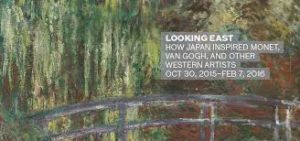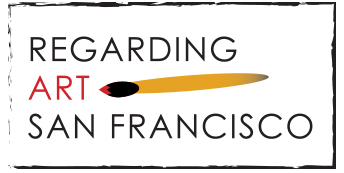Japanisme, Oui

Poster for Looking East show at Asian Art Museum. 2016
A friend asked for my thoughts on the Asian Art Museum’s current show Looking East, How Japan Inspired Monet, Van Gogh, and Other Western Artists. Certainly, it’s a very high quality show, broad-based from fine art to clothing, furniture, photography, the decorative arts. The signage is thorough and informative and the crowds it is attracting would be the envy of most museums.
What’s missing for me would be impossible to include: the shock of the new. Once upon a time, in about 1849 in Paris, virtually no one had laid eyes on anything Japanese. The operable aesthetic was that of Louis XIV (stately, opulent, finely wrought) as it had wended its way through rococo and neo-classicism. This was understood to be F-r-e-n-c-h; if you wanted to be chic, in the know, you collected French, hung it on your walls, dressed in it, ate off it and sat in it. And if you weren’t chic, not adhering to the current French mot, well, au revoir to you.
Into this aesthetic stranglehold, slowly began to appear Japanese images: shockingly colorful prints with unheard of proportions and off-center use of lines. First came woodblock prints, often as simple wrapping for breakable Japanese objects and on their heels came silk tapestries and kimonos with non-heraldic designs like butterflies, cranes, fans and lotus flowers. Then on other boats began arriving dinnerware, desk and table top accessories, screens. It was all so decoratif and the rage was on!! People of all classes were wild for the Japanisme; wearing it and collecting it became what status-conscious Parisians simply had to do. The effects were suddenly everywhere from the new more fully realized and sensual view of women (more sexy in their kimonos), to the use of posters for promotion (the beginning of advertising as we know it), and certainly in painting which was already being transformed (into Impressionism) by new information about the science of light.
In our age, the Eastern aesthetic – from food, to cars, to gadgets, to iconic designs and a host of other areas – is one component in daily, globalized life. So, while there is no shock in the Looking East show, it is interesting and informative to return to a time when the melding of East and West began in earnest.
* For more of my blog posts please go to LivingArt1.net

